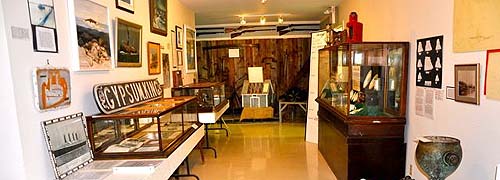 |
|
SHIPWRECKS
EXHIBIT
|
Between 1720 and 1946
there were hundreds of
ships wrecked in the
waters around Grand
Manan, which is
situated at the mouth
of the Bay of Fundy.
Ships entering the bay
had to negotiate high
tides, strong
currents, winds and
fog, and navigate past
the island and those
islands of its
archipelago, and
around its many
dangerous hidden
shoals and ledges. The
Shipwreck Gallery
documents a number of
the most famous.
|
|

Shipwreck Exhibits. |
|
|
|
About
the Collection:
|
|
Lord Ashburton:
The most famous local
shipwreck was of the
barque Lord Ashburton,
which was headed from
France to Saint John, NB,
in January 1857 when it
was blown off course by a
winter storm and into a
headland near Whale Cove
now known as Ashburton
Head. The shipwreck took
the lives of 21 seamen,
with 8 saved, but
ultimately only 5
surviving, one of whom was
the Danish sailor, James
Lawson, whose heroism
saved the lives of the
other surviving shipmates.
After a long convalescence
James Lawson remembered
the kindness of the island
folk and later returned to
settle and raise a family
on the island. He returned
with the trade of a
cobbler (ironically, he'd
lost all of his toes to
exposure in the
shipwreck), and he lived
into old age, frequently
retelling his shipwreck
story to the island's
school children. There are
several items from his
cobbler's workshop in the
Museum collection,
including his bench and
shoe forms, as well as
photographs of him in his
workshop and several
marine paintings of the
shipwreck.
Other Shipwrecks
Some
additional shipwrecks
featured in the gallery
include the Queen
(1841), The
Turkish Empire
(1879), the Gypsum
King (1906),
and the Hestia
(1909), with
shipwreck china, personal
items such as smoking pipes,
bottles, ship's bells
(including one from the Lord
Ashburton), deadeyes, a
ship's figure head, and
other such artifacts on
display.
|
|
There are also detailed
charts plotting the layout
of several shipwrecks,
mapped by underwater
archeologist and marine
artist Eric Allaby, who
invented an underwater
survey instrument (also on
display) in order to carry
out his surveys. The items
on display were all
recovered by divers such
as Eric, or local
fishermen who found them
entangled in their
dragging or seining
equipment while fishing.
|
|
| |
|
|
|